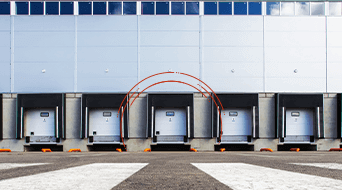What happens when the shipping company loses your freight?
If your company routinely ships freight via less-than-truckload (LTL) services, it's a good idea to take a few minutes to familiarize yourself with what happens if your shipment ends up missing.
What should I do if freight is missing?
If your whole shipment is missing, first track your shipment on the carrier's website to see if there's a time-stamped scan. Sometimes freight may not be lost, just delayed. If the tracking information is not clear, contact the carrier or your third-party logistics (3PL) provider to help investigate further.
Here's what to do if part of your shipment is missing:
- Review the bill of lading (BOL) and thoroughly examine the entire delivery to compare what was delivered to what was shipped.
- Check for shortages as goods are being unloaded and that all handling units are addressed to you.
- Note any shortages in detail on both the carrier's and the consignee's copy of the delivery receipt or proof of delivery (POD) prior to signing.
- When practical accept the delivery, pay the shipping charges and keep all your documentation.
- File a freight loss claim for the missing goods.
IMPORTANT: If the freight is damaged or lost, when practical, the shipment should be accepted. In all claims, it's required of the claimant that freight loss and damage be mitigated. A claim can then be filed for repair, replacement or short goods.
Where and how do shipments get lost?
To see where and how freight gets lost, it's important to understand how LTL shipments are moved. Freight is not transported straight from the origination point to the destination point. LTL freight is transferred through a perpetually moving "hub and spoke" system of terminals (with many spoke terminals going to each hub) between those two points. See below for a detailed overview of the process.
- On any given day, drivers take outbound trailers loaded with freight from the central area hubs out to the local spoke sites.
- The next day, the drivers bring the trailers back to the hubs for unloading of new freight picked up from the spokes.
- The freight unloaded at the hubs is then distributed to other trailers, which are bound for the spokes that are on the route to the shipment's final destinations.
While carriers try to reduce the amount of offloading and onloading, there are several scenarios that can result in missing LTL freight. The most common are below.
| Places freight can be lost | Ways freight can get lost |
| At the local terminal where it was offloaded | The freight may have been unloaded from the truck at the local terminal, then left behind somewhere on the dock or even in a storage trailer. |
| At a hub where it was offloaded | At the hub, it may have been unloaded but then mistakenly moved to the wrong area of the facility or loaded into the wrong trailer. |
| At a hub where it was reloaded after offloading | At the hub, it may have been reloaded into the wrong trailer. |
| At the final destination point | It may have made it to the correct final shipping facility, but then may have been delivered to the wrong customer. |
How do LTL carriers find lost freight?
When a carrier is made aware that freight is missing (which may be referred to as "Complete" or "Partial Shortage"), the dock search begins. This is a task typically handled by the destination terminal OS&D (Overages, Shortages and Damages) Department. A typical dock search process will include a combination of these steps:
- The OS&D specialist will first contact all the terminals where your freight was handled, however briefly, especially those where it was unloaded and then reloaded.
- If your shipment is not found by checking all the terminals, the OS&D rep will then send out a "BOLO" (i.e., "Be On the Lookout") to all terminals throughout the network system.
- At this point, the OS&D specialist will make additional calls, especially to the terminals identified as the most likely to have the missing freight.
- Typically, carriers anticipate locating missing freight within 7-10 days but can take longer depending on the carrier. It is extremely helpful to provide the carrier with clear descriptions of what was shipped, any special markings or logos on the packaging and photos of the entire shipment or packaging as it appeared prior to leaving the shipping location.
- If your shipment is still missing after those two rounds of contacting terminals and sending out BOLOs, it's probably time for you to file a claim for the missing freight.
How do I file a missing freight claim?
If your shipment cannot be located, you will need to submit the necessary missing freight claim as soon as possible. Expect to also submit all relevant documentation you have to help validate your claim of the freight loss. However, if a partial shortage after delivery and signing of the POD, you must notify the carrier within five days for consideration of your claim.
Be sure to check out our helpful resource on the roadmap to a successful freight claim.
Quick Tip to Help Prevent Freight Loss
At your company's end of the shipping process, the single best thing your team can do to help prevent missing shipments is to double-check every item to ensure proper labeling. Check all sides of each crate or pallet to ensure there are no old shipping labels or stickers from previous shipments. Remove or mark through any labels that might be confused as labeling for the current shipment. You may also want to consider sending a packing list or a copy of the BOL to the consignee (or requesting one from the shipper on inbound freight) and taking photos of each shipment prior to leaving your dock so there's no question on what is expected at delivery.
Partner With a 3PL To Ease Freight Hassles
Unishippers is a 3PL company for small to mid-sized businesses that ship small parcels and freight throughout the U.S. and internationally. We bring a vast network of leading national, regional and local carriers — along with being an Authorized Reseller of UPS® — to provide our 108,000+ shipping customers significant savings. We can also provide expert guidance — such as insuring your freight with UPS Capital® — to help you obtain the best outcome possible with lost or damaged freight.
Contact us for a free shipping assessment to see how we can save you time, simplify your shipping operations and reduce your costs.



